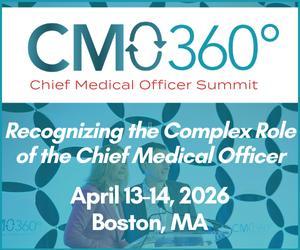Directing AstraZeneca's Oncology Strategies
Cristian Massacesi, MD, Chief Medical Officer and Oncology Chief Development Officer, AstraZeneca, discusses his ambitions for IO, the solutions he’s utilizing to realize them, and where we still need to put our focus to make real gains in cancer treatment.

What is the main challenge and goal for your role in AZ’s mission for IO?
The main challenge for my role is driving a clinical strategy that takes into consideration the complexity of cancer and gearing our portfolio to tackle this.
The goal for me is to rapidly advance the innovation in this space; complex issues mean you need to use every possible source or solution to help you solve that problem. We strive for this every day: embracing new, innovative solutions that can help us be more efficient in bringing medicines to patients that can impact cancer or one day cure it.
Can you give examples of such solutions that you’re using to achieve AstraZeneca’s goal of transforming cancer outcomes?
One solution is using novel tools and biomarkers to better understand the evolution of cancer. One such example is circulating tumor DNA (ctDNA). It has become more and more relevant in the way we can detect and monitor cancer, and importantly, it is based on a less-invasive blood test rather than tumor biopsies.1 When a patient receives treatment, ctDNA gives us important information on whether there is persistence of circulating tumor DNA.2
Another solution is the use of digital solutions to enhance clinical trial delivery. For example, we can reduce hospital visits for patients through devices that measure blood pressure, heart rate, oximetry, etc., which are the typical baseline assessments needed in a trial.3 We can implement digital solutions for our study personnel; they too can reduce hospital visits if we are able to transfer data from the investigator to the sponsor digitally.3
"We need to change the nature of clinical trials: make them more focused, more adaptive and less burdensome to patients – all so we can bring medicines to patients sooner and increase the chance of successful studies."
AZ is heavily involved in precision medicine, but how are you expanding in that space?
I think we can expand the concept of personalized medicine beyond the small molecule. The concept of precision medicine is actually incredibly relevant, independent of the modality that you are using. The aim is always the same, particularly for oncology: identifying and testing specific biomarkers to guide the best drug candidate that can have the highest effect. With precision medicine, you have a molecular target for which you develop a medicine, and you use that medicine in patients who have that molecular alteration in their tumors.4
What hurdles make personalized medicine for IO remain so challenging?
The first is the complexity of cancer, especially in solid tumors, and being able to detect at least the key drivers in each patient.
The second challenge is integrating all our data into something actionable and robust to inform our decisions. Earlier, I spoke about ctDNA, but we have other technologies we are applying, like artificial intelligence, and we need to be able to put these technologies together to best inform our decision-making in every stage of development.
The last challenge is more on the delivery side. The way clinical trials are done today is very similar to 20-30 years ago.18 We need to change the nature of clinical trials: make them more focused, more adaptive and less burdensome to patients – all so we can bring medicines to patients sooner and increase the chance of successful studies. There are novel approaches that can help us increase the efficiency and outcomes of clinical trials and, importantly, enhance patient experience.
What progress in expanding personalized medicine are you enthusiastic about?
The concept of precision medicine is broader today because of advancements with new modalities, such as antibody-drug conjugates. Antibody-drug conjugates are smart ways to give a more targeted chemotherapy because you can deliver the cytotoxic payload using an antigen or target related to the specific cancer cell. We know chemotherapy works, but the issue is it isn’t selective.5
In immuno-oncology, we are learning more and more about the immune system. Now, we have specific targets that we can try to target with our next-generation immunotherapeutics. A targeted, precision medicine approach is essential to achieve our ambition to develop transformative drugs that can bring the highest benefit to patients and one day be able to cure cancer.
How do we get to the next phase of IO?
In immuno-oncology (IO), our challenge is moving to the 2.0 phase – the next-generation IO. The first wave of immunotherapies was incredibly successful.6 We were able to overcome immune suppression with checkpoint inhibitors like PD-1, PD-L1, CTLA-4, etc. – but there were learnings here about tolerability and IO-sensitive tumor types.7 To go to the next level, we must introduce novel targets. We’re starting to see promising signs of what those targets could be, such as TIGIT, LAG-3, TIM-3, etc.8
Then, the next challenge is delivering inhibition of those targets in a unique, more innovative way. As a company, we believe in bispecific antibodies because they allow for the delivery of two differentiated modalities at the same time, and thus, you can tackle two important IO mechanisms simultaneously, with each element of the bi-specific doing the job it is meant to do.9 We are continuing to invest and develop in this because we believe this novel mechanism of action may bring additional benefit to patients.
"T-cell engagers and cell therapies – through chimeric antigen receptor therapy (CAR-T) or T-cell receptor therapy (TCR-T) – represent the ultimate way to activate the immune system against cancer."
What’s your commitment in the space of cell therapy, and why?
I truly believe that T-cell engagers and cell therapies – through chimeric antigen receptor therapy (CAR-T) or T-cell receptor therapy (TCR-T) – represent the ultimate way to activate the immune system against cancer. It’s not only about activating the T cells but bringing them where the tumor is. Fundamentally, we want to introduce these engineered immune cells and send them where they are needed to target cancer cells.
These new modalities should open up the field of IO completely.10 T-cell engagers and cell therapy will be very important in the context of solid tumors, specifically for some high-prevalence tumor types – such as prostate, colon or pancreatic cancer – where there are limited to no available IO options.11,12 Therefore, therapies targeting tumor drivers are of crucial consideration in this context.
What are the key trends that are having a big impact on your work?
I mentioned ctDNA and the value of digital health, especially in the context of clinical trials and in the concept of patient centricity. Another area that is becoming more integral to our work is real-world evidence (RWE) and artificial intelligence (AI).
RWE and AI are very important for medicine development, not only at the discovery level, but also in late-stage development. There is a richness in data out there that has the potential to accurately inform the outcomes of patients, can help us understand where the medical need is, and can be used to benchmark.13
One limitation is accessibility. Today, RWE is very US-based, however, as we are a global company, we need datasets from other geographical regions to support decision-making. It’s something we’re partnering with external companies on, as well as working on internally. For instance, beyond the US and our collaboration with Tempus for example14, we’re working with SophiaGenetics15, and we’re partnering with academic institutes, including in the EU with the support of EHDEN (European Health Data and Evidence Network)16, and also in Japan with the sponsorship of SCRUM17. In turn this supports wider use of real-world data for broader healthcare research purposes.
Where do you see your strategy in IO next?
Our strategy is very much focused on the potential of combinations. Cancer, especially in solid tumors, cannot be defeated through one modality. This is why our focus is to develop the next generation of antibody-drug conjugates (ADCs), radioconjugates, and more. We want to continue to develop the next-generation IO assets. Bispecifics can be the next modality today, and T cell engagers and cell therapy can represent the modality of the future.
Bringing forward together ADCs, radioconjugates, novel targeted therapies, and the next-generation IO can help us deliver the future of cancer treatments – and we hope one day a cure for cancer in every form.
For more information on IO360º Summit, click here.
References:
1Cheng F et al. Circulating tumor DNA: a promising biomarker in the liquid biopsy of cancer. Oncotarget. 2016; 7(30): 48832-48841.
2Fisher R, Pusztai L, Swanton C. Cancer heterogeneity: implications for targeted therapeutics. Br J Cancer. 2013;108(3): 479-485.
3Rosa C, Marsch LA, Winstanley EL, et al. Using digital technologies in clinical trials: current and future applications. Contemp Clin Trials. 2021;100:106219.
4Stein MK, Oluoha O, Patel K, et al. Precision Medicine in Oncology: A Review of Multi-Tumor Actionable Molecular Targets with an Emphasis on Non-Small Cell Lung Cancer. J Pers Med. 2021;11(6):518.
5Peters C, Brown S. Antibody-drug conjugates as novel anti-cancer chemotherapeutics. Biosci Rep. 2015;35(4):e00225.
6 Eno J. Immunotherapy Through the Years. J Adv Pract Oncol. 2017;8(7):747-753.
7Wang D, Wu X, Sun Y. Therapeutic targets and biomarkers of tumor immunotherapy: response versus non-response. Sig Transduct Target Ther. 2022;7(331).
8Cai L, Li Y, Tan J, et al. Targeting LAG-3, TIM-3, and TIGIT for cancer immunotherapy. J Hematol Oncol. 2023;16(101).
9Ordóñez-Reyes C, Garcia-Robledo JE, Chamorro DF, et al. Bispecific Antibodies in Cancer Immunotherapy: A Novel Response to an Old Question. Pharmaceutics. 2022;14(6):1243.
10.Finck AV, Blanchard T, Roselle CP, et al. Engineered cellular immunotherapies in cancer and beyond. Nat Med. 2022;28(4):678-689.
11The University of Texas MD Anderson Cancer Center. Why doesn’t immunotherapy work for everyone?. https://www.mdanderson.org/cancerwise/why-doesnt-immunotherapy-work-for-everyone.h00-159385101.html. Accessed October 27, 2023.
12Weng J, Li S, Zhu Z, et al. Exploring immunotherapy in colorectal cancer. J Hematol Oncol. 2022;15(95).
13 National Cancer Institute. Artificial Intelligence - Opportunities in Cancer Research. National Cancer Institute website. https://www.cancer.gov/research/areas/diagnosis/artificial-intelligence. Accessed October 26, 2023.
14 Tempus. Tempus Signs Strategic Collaboration Agreement with AstraZeneca to Advance Oncology Therapeutics [press release]. https://www.tempus.com/news/pr/tempus-signs-strategic-collaboration-agreement-with-astrazeneca-to-advance-oncology-therapeutics/. Published November 19, 2021. Accessed October 26, 2023.
15Sophia Genetics. SOPHiA GENETICS Enters New Collaboration with Memorial Sloan Kettering Cancer Center and AstraZeneca to Address Global Inequalities in Comprehensive Cancer Care [press release]. https://www.sophiagenetics.com/press-releases/sophia-genetics-enters-new-collaboration-with-memorial-sloan-kettering-cancer-center-and-astrazeneca-to-address-global-inequalities-in-comprehensive-cancer-care/. Published October 18, 2023. Accessed October 26, 2023.
16Innovative health initiative. EHDEN. https://www.ihi.europa.eu/projects-results/project-factsheets/ehden. Accessed October 27, 2023.
17National Cancer Center Japan. Participation method for companies/participating companies. http://www.scrum-japan.ncc.go.jp/company_participate/index.html. Accessed October 27, 2023.
18Eichler H, Sweeney F. The evolution of clinical trials: Can we address the challenges of the future?. Clinical Trials. 2018;15(51):27-32.










